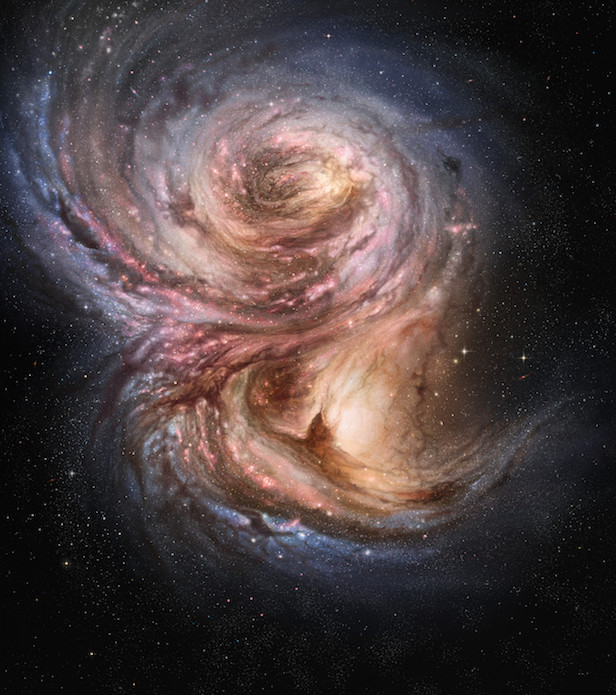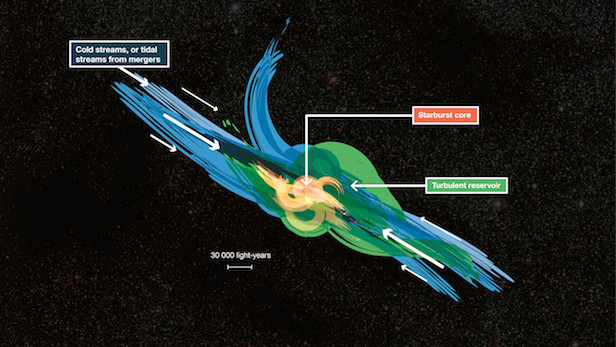Astronomers observe complex molecules in starburst galaxies
The detection of these complex molecules have shown huge hidden reservoirs of turbulent gas in distant structures

An artist’s impression of the distant galaxy SMM J2135-0102 shows large bright clouds, which are more importantly regions of intense star formation. Image credit: ESO/M. Kornmesser
By using the Atacama Large Millimetre/submillimetre Array (ALMA), a team of astronomers have detected a gigantic accumulation of cold gas that surrounds distant starburst galaxies. This discovery challenges what we know about the evolution of galaxies and, in particular, the star formation in these structures, which exhibit a much higher rate than the Milky Way.
In order to make this discovery, astronomers tracked the spectral signature of the carbon hydride molecule CH+, also known as methylidynium. This was one of the first three complex molecules ever detected in the interstellar medium, but it has always been a mystery since it is extremely reactive, which makes it vanish quicker than other molecules.
“CH+ is a special molecule. It needs a lot of energy to form and is very reactive, which means its lifetime is very short and it can’t be transported far. CH+ therefore traces how energy flows in the galaxies and their surroundings,” says Martin Zwaan, an astronomer at European Southern Observatory (ESO).
Out of the six starburst galaxies analysed, five of them showed strong signals for the CH+ molecules. To help understand the importance of detecting them, there is an appropriate analogy to consider, which is about a boat sailing in the middle of a dark ocean. When the boat is sailing across the ocean, it causes a disturbance that makes the plankton underneath emit light. So similar to how the turbulence of the water, caused by the boat, is shown by emission of light from plankton, the turbulence of the gas is shown by the detection of CH+. As to what causes this disturbance is unsure, but it helps us understand star formation within the galaxy.

This illustration reveals how gas falls into the starburst galaxies and end up as the turbulent reservoirs of cool gas. Image credit: ESO/L. Benassi
The observations have revealed dense shock waves, powered by intense galactic winds originating from inside the galaxies’ star forming regions. The winds continuously push material out of it, but they can be re-captured by the galaxy’s gravitational pull. This is what creates the surrounding reservoir of cold, low-density gas, which extends more than 30,000 light-years from the star-forming region.
“With CH+, we learn that energy is stored within vast galaxy-sized winds and ends up as turbulent motions in previously unseen reservoirs of cold gas surrounding the galaxy,” says Edith Falgarone, of Ecole Normale Supérieure and Observatoire de Paris, France. “Our results challenge the theory of galaxy evolution. By driving turbulence in the reservoirs, these galactic winds extend the starburst phase instead of quenching it.”
The results have determined that galactic winds alone could not replenish these reservoirs of gas. They suggest that this contributing mass could come from galactic mergers, or accretion from hidden gaseous filaments. “This discovery represents a major step forward in our understanding of how the inflow of material is regulated around the most intense starburst galaxies in the early Universe,” says ESO’s Director for Science, Rob Ivison. “It shows what can be achieved when scientists from a variety of disciplines come together to exploit the capabilities of the world’s most powerful telescope.”
Keep up to date with the latest space news in All About Space – available every month for just £4.99. Alternatively you can subscribe here for a fraction of the price!




